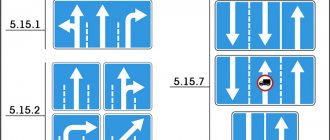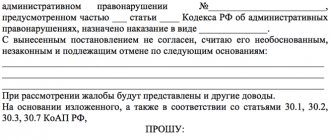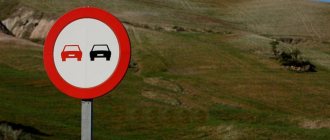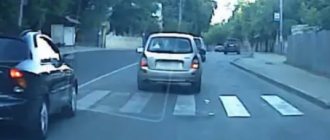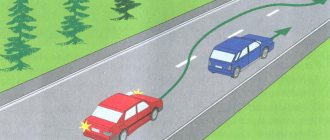What is overtaking?
Overtaking is getting ahead of one or more cars and entering the oncoming lane. In this case, the driver must return to the original lane or side of the roadway.
Previously, traffic rules defined overtaking as only passing ahead of moving vehicles. Now the interpretation has changed, so overtaking can also be considered passing a stationary car.
Overtaking always means driving into the oncoming lane. But it is only allowed on sections of the highway where there is no clear prohibition on crossing. For example, a two-lane road without a dividing double solid line.
Overtaking is getting ahead of one or more vehicles on the road and driving into oncoming traffic.
Advancing and overtaking: the difference
Traffic rules differentiate between overtaking and ahead. Overtaking is moving at a speed higher than that of passing cars within your lane. Overtaking is carried out by driving into the oncoming lane and mandatory returning to the starting lane.
Another difference is the method of advance. When overtaking, it is possible only on the left, and when ahead - both on the left and on the right. In addition, overtaking as a maneuver is strictly limited by traffic regulations and is prohibited in many cases. But advance can be made in almost any situation. The only exception is that advance cannot be made in front of a pedestrian crossing if other vehicles have slowed down or stopped.
Overtaking cannot be done by driving into oncoming traffic, otherwise it is considered overtaking.
Overtaking rules
Before starting the maneuver, the driver must make sure that the lane where he is going to change lanes is clear at a distance sufficient for overtaking. But the main thing is that overtaking should not create a danger for other cars (Section 11.1 of the Traffic Regulations).
It turns out that before starting the maneuver, the driver must look in the rear-view mirrors and make sure that other cars have not begun to overtake. Only after this he has the right to turn on the left turn signal and begin overtaking.
According to clause 11.2 of the traffic rules, overtaking is prohibited if the vehicle moving ahead:
- started to give a left turn sign;
- overtakes or goes around an obstacle.
If a car moving behind begins to overtake, the maneuver is also prohibited.
The driver who is overtaking is prohibited from maneuvering sharply and impeding the movement of other cars. He must maintain a safe distance and speed when returning to the starting lane. Simply, don’t cut off other cars. In this case, the driver of the overtaken vehicle must not interfere with overtaking. For example, sharply increase speed.
Overtaking is prohibited if drivers in front or behind you are already doing so.
Overtaking: DANGER BY GOOD WILL or UNSURE DO NOT OVERTAKE
Overtaking is paradoxical. On the one hand, this is the most dangerous maneuver, during which approximately every fifth accident occurs, but at the same time, every third person killed out of 3,000 killed on the roads in Kazakhstan is killed as a result of a collision in the oncoming lane due to driver errors in performing the most dangerous maneuver - overtaking. on the other hand, we take risks voluntarily. After all, no one forces us to overtake a line of trucks rushing in the rain at high speed, for the sake of the dubious prospect of arriving home from work five minutes earlier... Let's start by repeating the Rules of the Road of the Republic of Kazakhstan, what is “OVERTAKING?” Overtaking is called “Ahead of one or more vehicles funds associated with leaving the occupied lane.” Since October 21, 2021, changes have been made to the traffic rules of the Republic of Kazakhstan and they again affected OVERTACKING. Now OVERTAKING is the process of getting ahead of one or more vehicles by leaving the occupied lane and then returning to the previously occupied lane. About driving with a minimum permitted distance was removed 2 years ago, now it is unclear how the term overtaking can be interpreted when driving in a dense traffic flow in one direction if the driver, for example, 20-30 meters from the vehicle moving in front, changed lanes into the adjacent lane, then into the adjacent lane with then the car overtook him at a higher speed. About 10 meters away I changed lanes to the right - this is most likely changing lanes and getting ahead, but it’s difficult to attribute this to overtaking. Everything is leading to the fact that the term overtaking will take on the meaning to which it is gradually approaching. That is, advancing and entering the oncoming lane. This is in the Rules of the Republic of Kazakhstan. In Russian traffic rules, overtaking is considered to be the advance of one or more vehicles, leaving to the side of the lane intended for oncoming traffic and then returning to the previously occupied lane. (side of the roadway)
And this makes sense, since we are talking about the most dangerous maneuver, and the main danger lies in wait for the driver in the oncoming lane.
I did not find any permitted overtaking on the RIGHT in the Russian Rules. At the beginning we say that overtaking is done on the left side, and then we begin to explain that there is also overtaking on the right? This is when the vehicle in front gave a signal to turn left and began to execute it, introduced! And what does it look like? It is correct to “Detour” a vehicle making a left turn or changing lanes, if the detour involves leaving a previously occupied lane.
OVERTAKING CAN BE WITH AND WITHOUT ENTRY INTO THE ONWARD TRAFFIC LANE - THIS IS IN THE TRAFFIC RULES OF THE RK. OVERTAKING A VEHICLE WHOSE DRIVER HAS SIGNALED A LEFT TURN AND HAS STARTED PERFORMING A MANEUVER IS CARRIED OUT FROM THE RIGHT SIDE,
But if the car is stationary, allowing oncoming traffic to pass, and the driver of the green car went around it on the right and did not return to the left lane - what will happen? BYPASS, or ADVANCE, but not OVERTAKING.
Overtaking traffic in the adjacent lane at a higher speed is not considered overtaking.
Such a maneuver is also considered ADVANCE.
You can read these elementary truths, which are taught in driving schools, in a traffic rules textbook. It would seem that it is not clear - follow the Rules, and you will get rid of troubles and troubles. But it turns out that not everything is so simple. If we exclude outright reckless drivers and hooligans who do not care about the provisions of the Rules and do not take into account other road users, the rest of the drivers find themselves in conflict situations that occurred due to the fact that they did not take something into account, did not think, and something simple, and they didn’t know. Because this comes with experience and is learned at the cost of mistakes, which are not always harmless, we want to talk about the subtleties that make overtaking quite SAFE.
It is generally accepted that overtaking is the most dangerous and difficult maneuver. Although in terms of chapter 1. In the definition of MANEUVERING, there is no overtaking. It is impossible to do without overtaking on the road. As statistics show, road accidents and the most terrible incidents on the road, which lead to serious consequences, death and injury to people, often occur only because of violations of the rules of overtaking by driving into the oncoming lane! All of our country roads, except Rudnenskaya, are narrow roads on which overtaking is carried out by entering the lane of oncoming traffic. Imagine for a second that all the roads suddenly became at least four lanes and oncoming traffic was separated by a steel fence, not like on the Rudny highway, where the dividing strip does not protect in any way from an oncoming car, but at least with such bollards with steel guides, they they will not save someone who wants to drive into oncoming traffic from a truck. But if a passenger car hits them at an acute angle, then such a fence may well prevent driving into the oncoming lane. In Moscow, they have already tested road fencing entirely made by Russian engineers. This fence withstood a bus that crashed into it at an angle of 20 degrees. If a bus can withstand it, then a passenger car can withstand it freely. The complexity and danger of overtaking lies in the fact that in a short time the driver has to calculate many factors and options that affect the safety of the maneuver. This includes control over the trajectory of your car, the speed and length of the overtaken vehicle, the distance and speed of oncoming vehicles, which is especially important! It is because of errors in determining the last factor that serious accidents occur.
When entering the oncoming lane, correctly assess the speed of oncoming traffic; the smaller its dimensions, the lower the speed appears. In addition, the speed of dark-colored cars is usually underestimated. At night and in conditions of insufficient visibility (for example, in fog), the speed of an oncoming vehicle is underestimated, and the distance to it appears greater than it actually is. Also, road bends, ascents and descents significantly reduce the accuracy of the assessment. Especially when overtaking trucks with a trailer, this is, firstly, their length and, accordingly, an increase in overtaking time, and we also need to take into account our national feature - this is the wobble of the trailer, and significantly, but more on that later. It is necessary to take into account that the speed of your and the oncoming car is added up: if you are moving at a speed of 80 km/h, and the oncoming car is at the same speed, then you and the oncoming vehicle are approaching each other at a speed of 160 km/h. This suggests that the approach occurs at a speed of 44.4 m/s, that is, a distance of 200 meters will be covered in less than 5 seconds.
Before you start overtaking, you need to decide for yourself - is it necessary to overtake in this particular situation? Overtaking is necessary to maintain the desired speed. However, it is advisable to overtake those vehicles that are moving at a speed lower than the speed of the traffic flow. In a city where traffic is regulated by traffic lights, overtaking has no benefit; on the contrary, each overtaking person creates emergency situations; moreover, the driver makes unnecessary gear changes, unnecessary braking, and creates unnecessary hassle for himself.
. Those drivers who drive into oncoming traffic on the 2-lane roads of Abay and Gagarin streets grossly violate the Rules. Al-Farabi. But this absolutely cannot be done. For driving into the oncoming lane (clause 9.2 of the RK traffic rules). Under Article 596-3. Code of Administrative Offences. RK year of deprivation of rights. The first sign of an unskilled driver is frequent unnecessary overtaking. We see. How does such a driver overtake everyone, sometimes making risky maneuvers, breaking the Rules, risking getting into an accident, and the end result! You catch up with him at the next intersection and stand together at the traffic light with a prohibitory signal. Then he starts again and the race is on again! And again you calmly approach him at the next intersection.
When returning to a previously occupied lane, many drivers violate the Rules and “cut off” law-abiding drivers who are forced to slow down and give way to reckless drivers overtaking them. Experiments have established that when overtaking “on the move,” the safe distance to the oncoming car is numerically equal to 9 times the speed of the vehicle being overtaken (40 km/h x 9 =360), and when overtaking while waiting, it is 10–11 times the speed (40 km/h x 10=440). When driving outside the city, the road should be visible at a distance of 500-700 meters, and in the city 300-460 meters . Driving school students, when the teacher explains the topic “OVERTAKING,” ask a simple question: “What should be the speed when overtaking?” In fact, it does not matter what the speed of the overtaking or being overtaken is, but the difference in speed between the overtaken and the overtaking vehicle is DECISIVE, i.e. How much faster are you driving than the vehicle you intend to overtake? This factor is decisive in determining the area required to complete the maneuver safely. The higher the difference in vehicle speeds, the shorter the distance and overtaking time, and vice versa. So, for example, if the speed of the overtaking vehicle is 30 km/h, and the overtaking vehicle is 60 km/h, (30). the overtaking distance is 192 meters. And the time is 13.7 seconds. At the same time, at a speed of 50 and 70 km/h (20), it will already be 455 and 19.5, that is, it will increase by more than 2 times.
Now let's move on to the nuts and bolts of overtaking.
Before overtaking, the driver must ensure that:
– The lane into which he intends to enter is clear at a distance sufficient for overtaking, and with this maneuver he does not interfere with oncoming vehicles or vehicles moving behind in the same lane (clauses 19.11 and 19.12 of the Road Rules of the Republic of Kazakhstan).
– The vehicle following behind in the same lane did not begin to overtake.
– The driver of a vehicle moving ahead in the same lane did not signal to turn left.
– Upon completion of overtaking and entering the lane (side) of oncoming traffic, he will be able, without interfering with the overtaken vehicle, to return to the previously occupied lane (one of the most common violations of the rules is the so-called cutting) .
— It is necessary to use rear-view mirrors in the cabin and side mirrors, and be sure to look out the driver’s side window, not forgetting about the “maneuvers” of visibility zones when a car located at a threatening close distance is not visible through the rear-view mirrors.
— Make sure that the driver of the overtaken car will not change lanes, that is, you need to look and calculate whether there are intersections or exits from the road ahead that the overtaken driver can turn onto. These options often help avoid accidents.
On western highways, truck drivers walking in a convoy, seeing that the driver of a car trying to overtake, doubts whether they see him. Drivers of road monsters try to help their smaller brothers - drivers of cars; for this, the truck driver turns on the right turn indicator and moves to the right, and all other trucks duplicate this maneuver. I myself found myself in such situations and was very surprised by such politeness when drivers of such large cars let you through. This is not accepted here, on the contrary, KAMAZ drivers drive in the middle of the roadway, look in the mirror and smile - they say, go for it, overtake if you can. You need to choose the moment when the dangling trailer moves to the right, and at that moment try to pass and not get under the trailer of the car you are overtaking. Moreover, looking at the road so as not to fall into a hole is not for the faint of heart.
A very important point is the final phase of overtaking, the main rule of which is not to interfere with the overtaken vehicle and not to force it to brake sharply or turn to the side. I remember an incident that happened on the Fedorovka-Kostanay highway, when the driver of a Zhiguli started overtaking an Ikarus without judging the distance to the oncoming car. And to avoid a head-on collision, he literally dived under the Ikarus, cutting it off. The driver of the Ikarus, in order to avoid hitting the Zhiguli, slowed down on a slippery road, he was carried out onto the washed out side of the road, the bus went into a ditch and overturned, six people died - this is the tragic end of overtaking and the wrong actions of the Zhiguli driver.
And now about the mutual courtesy of drivers involved in overtaking. By turning on the left turn signal, you warn those driving behind you. The driver of the car being overtaken must be warned with headlights and outside the city with a sound signal. If he then turned on the left turn signal, then perhaps he sees a danger ahead, about which he is sending you a warning. In this case, refuse to overtake. Overtaking needs to be done quickly, so you need to move with acceleration, and create a speed advantage of at least 15-20 km/h than the person being overtaken. It is precisely in these conditions that the advantage of cars with a powerful engine of 2 liters or more is felt, and these are, as a rule, foreign cars. They are dynamic and allow drivers to overtake painlessly, easily responding to the gas pedal. But on less powerful cars you need to switch to a lower gear. Try not to linger in the invisible of the driver being overtaken; maintain a gap of at least the width of your vehicle, especially if the vehicle being overtaken has a trailer. Do not move for a long time in parallel rows with him. If a long truck or bus overtakes you and overtakes you slowly, then you either move ahead of him or slow down, making his task easier, but do not move in parallel - this is fraught with consequences . And - attention! If you have doubts about the success of overtaking, return to your original place. You can start changing lanes only when both headlights of the vehicle being overtaken are visible in the rearview mirror. You need to change lanes smoothly, without reducing speed or braking.
Using “flashing” when overtaking : turn on the left turn signal when leaving the occupied lane, then turn it off when ahead; turn on the right indicator when returning to your lane. Many people do not turn off the left turn signal during the entire overtaking, thereby misleading drivers of oncoming cars.
What mistakes are most common for novice drivers?
- Overtaking is too extended due to the small difference in the speeds of the overtaking and overtaken cars, or they do not take into account the fact that overtaking a long vehicle (road train, bus) requires 5 times more free road than when overtaking ordinary cars.
- Too long observation when inspecting the situation from the side and behind before overtaking. This leads to the fact that unexpected changes in the situation ahead go unnoticed, and the car may deviate from the correct trajectory. Before overtaking, you need to inspect the situation carefully, but quickly.
- Early and abrupt termination of overtaking due to incorrect estimation of speed driving or making a sharp turn without traveling a sufficient safe distance. You can complete overtaking only by getting ahead of the overtaken vehicle at a sufficiently large distance.
- Complete absorption in your actions while driving to the detriment of monitoring the situation ahead. The road situation must be monitored throughout the maneuver.
If they overtake you. What should you do?
- Observe the situation ahead and, if danger arises, warn the overtaking person by turning on the left turn signal several times.
- If necessary, reduce your speed by turning on the right turn signal, which means that you see an overtaking vehicle and give way to it. Move to the right, and the driver overtaking you will finish passing faster. Another time you will find yourself in the place of the overtaking one.
- Before making a maneuver, give your turn signal in advance, at least 5 seconds before the maneuver.
- Do everything possible to avoid becoming involved in a traffic accident.
If overtaking is done at night, the headlights shining through the rearview mirror can blind the driver in front, so it is necessary to switch the high beam headlights to low beam in advance as soon as you are sure that the signal to overtake has been received. Turn on the high beams again when the vehicles are level with each other. We have already said that at night you need to avoid overtaking at speeds above 90 km/h , because the stopping distance exceeds the visibility of the road.
In rainy, slushy weather, it is not recommended to drive close to the car you are overtaking, as water and dirt flying out from under the wheels contaminate the windshield and impair visibility. In this case, the distance must be increased. The actions of overtaken vehicles are very important. They are prohibited from preventing overtaking by exceeding the speed limit, entering the overtaking lane, or performing any other actions.
A disciplined, competent driver, making sure that his vehicle is being overtaken, gives a hand signal, a right turn signal, that he sees and gives way to the overtaking person. If the driver of the car being overtaken sees obstacles ahead that interfere with overtaking, he must show with a gesture that overtaking is dangerous, but should not interfere with overtaking. Such mutual observance by drivers of overtaking rules creates a safe environment on the road.
Due to the difficulty and danger of overtaking, overtaking is prohibited in certain places and conditions:
OVERTAKING IS PROHIBITED AT UNCONTROLLED INTERSECTIONS ON NON-MAIN ROADS.
AT PEDESTRIAN CROSSINGS IF THERE ARE PEDESTRIANS ON THEM.
AT RAILWAY CROSSINGS AND CLOSE TO 100 meters IN FRONT OF THEM.
OF A VEHICLE PERFORMING OVERTAKING OR DETAILING (DOUBLE OVERTAKING).
AT THE END OF THE RISE
NEAR DANGEROUS ROAD CURVES and ON OTHER ROAD AREAS WITH LIMITED VISIBILITY ENTERING THE SIDE OF ONWARD TRAFFIC.
AT CONTROLLED INTERSECTIONS WITH ENTRANCE TO THE LANE (SIDE) OF ONWARD TRAFFIC.
IT IS PROHIBITED TO DRIVE (OVERTAKE) INTO THE LEFT LEFT LANE ON TWO-WAY TRAFFIC ROADS WITH THREE LANES. POINT-9.3. Traffic rules of the Republic of Kazakhstan.
IT IS PROHIBITED TO OVERTAKE (EXIT) THROUGH THE DOUBLE SOLID LINE 1.3.
ON ROADS WITH 4 (FOUR) OR MORE LANES FOR TRAFFIC IN BOTH DIRECTIONS. ACCORDING TO THE NEW Code of Administrative Offenses of the Republic of Kazakhstan, such a violation is subject to deprivation of rights for six months
AT UNregulated intersections of equal roads.
I would like to emphasize that the largest number of accidents outside the city when overtaking occur at the end of the climb, i.e. closer to the top, with driving into oncoming traffic. In addition to the climb, participants with limited visibility are turns where visibility is less than 100 meters. So, in such areas, overtaking is strictly prohibited, because you are entering the oncoming lane, and the drivers of oncoming cars do not see you, and in this situation it is quite difficult to avoid an accident, especially if the oncoming car is a truck. Road signs also inform us about the prohibition of overtaking; if they have a sign, then it indicates the prohibition zone, and if without a sign, then the sign is valid until the next intersection or until the end or beginning of the populated area, the specified point, indicated by a sign on a white background.
ATTENTION! In the Russian Federation, overtaking is prohibited: on BRIDGES, overpasses, overpasses and under them. And also in tunnels. Don’t forget in the Russian Federation, overtaking is when you enter the oncoming lane. In the Republic of Kazakhstan, on all bridges there is a double solid line - 1.3, or a single line - 1.1. Which you also can’t cross. In tunnels, oncoming traffic is usually separated by a “ bumper”
You cannot overtake through solid marking lines, especially double solid markings - 1.3. And if there are two lines - solid and broken, 1.11, then you can overtake from the side of the broken line, and if you entered the lane of oncoming traffic, then you need to return to the previously occupied lane. Why am I telling you in such detail - I just want drivers, or students who are preparing to become drivers, after reading this article, to refresh their memory of this one of the most important sections of the Rules. And “Azov” of road safety, I have seen many accidents that occurred due to violations of overtaking rules. When a passenger car drives into the oncoming lane and is driven off the road by a truck. From the impact of the Mercedes, which was overtaking at a speed of 200 km/h and did not have time to take its starting position, which is not surprising at such a speed, the truck rolled back 20 meters. Or motorcyclists, hitting a ZIL 130 in an Izha, tore the engine off its mounts, and the bodies of the motorcyclists smashed the cabin and injured the driver. You need to know this, imagine and always remember that a car is not only a means of comfortable transportation, but in inept hands, if the Rules are violated, it is a formidable weapon for others, for all road users. Be safe
CONSIDERING THE COPICALITY OF THIS TOPIC FOR MOTORISTS, WE DECIDED TO DEVOTE ONE OF SECTIONS 7 OF THE TRANSMISSION TO “ALAU” WHICH WILL BE HELD ON FRIDAY, November 18, 2016 at 20.30.
So be healthy and safe and good luck on your journey.
14, total, today
Also interesting for you!
With the client frankly about the secret in the anniversary year of the 20th anniversary of the driving school.
Attention - ice!
VIOLATION AND PUNISHMENT
Learning the rules
Driving a crossover NISSAN - TERRANO AUTOMATIC. What we learn from is what we will ride on. We…
Calendar for drivers Poems for drivers! Poetry and safety go and go side by side...
← Previous post
Next entry →
Leave a comment Cancel reply
Typical overtaking situations picture “Overtaking situations”
The three most common types of violations are:
- Overtaking across a solid line. It doesn’t matter whether there is a sign prohibiting overtaking or not - the maneuver cannot be performed.
- Unfinished maneuver. The driver crosses a single or double solid dividing line, drives into oncoming traffic and returns to his lane without getting ahead. This is also a violation for which a fine or deprivation of a driver's license is provided.
- Repeated violation. The driver will be deprived of his license for a period of 1 year if the violation is repeated. That is, if within one year after the punishment for crossing a continuous line while overtaking there is a new case.
Let us note one nuance. If a repeated violation is recorded by a traffic camera, and not live by a traffic police officer, a fine will follow.
Completing overtaking through a solid road when starting on an intermittent road
The traffic rules state that there must be intermittent markings on the road before a solid line. It is standard and printed in the form of small white rectangles. The distance between them can be large. If the marking changes, the lines become three times longer and the distance between them decreases, then the lines are continuous next to each other. It is prohibited to overtake in such areas, otherwise you may not only receive a fine, but there is also a high risk of an emergency.
But what often happens is that the driver begins to perform a trick on a broken line, and in the process it turns into a solid line and returns to his lane through it. On the one hand, there is no violation, because the oncoming traffic was driven through an intermittent lane. But the continuous road begins according to GOST, which means about 50 meters on the road before it there will be markings with long rectangles and small gaps between them.
Is it possible to complete overtaking in this way, as judicial practice says?
A similar situation, when overtaking began on a broken line and ended on a solid line, is not uncommon and is controversial. This is not surprising, because all traffic rules participants look at it differently:
- driver;
- patrol officer;
- court.
In 2021, overtaking across a solid line is one of the strictest violations, so traffic police inspectors issue a large fine. At the same time, the driver has his own opinion on what happened; the Supreme Court can decide everything in its own way.
In other words, you cannot complete overtaking through a continuous marking, even if the overtaking was started on an intermittent marking. In practice, this is punishable by a fine of 5 thousand rubles or deprivation of a driver’s license for a period of 4 months to six months.
Attention! Previously, such violations of the rules only resulted in deprivation of rights, but after numerous complaints, the Supreme Court made a decision according to which each case is considered individually.
In 2021, a new clause 9.1(1)0 appeared in the traffic rules, which states that on any two-way road you cannot drive into the oncoming lane if it is separated by tram tracks, a dividing strip, etc.
But exceptions are possible. For example, a car owner began overtaking in compliance with the rules, but the car in front accelerated, so it was not possible to complete the maneuver without violating it. This is not an isolated case where a driver could not willingly ignore the law, so if such a situation arises, you need to prove your case to a traffic police officer.
If you went to overtake through an intermittent traffic jam and returned through an intermittent traffic jam
According to traffic rules, driving in oncoming traffic is prohibited if it is separated by a solid single or double line. Clause 9.1. (1) determines that you cannot cross them, and you can only be to the left of the marking line if they are absent.
This means that if the maneuver began through a broken line and ended also through it, but at the same time it was necessary to completely drive through a solid line, then there is still a violation. If this happens, then you need to do the following:
- Do not overtake a vehicle if you have any doubts. A solid line does not appear out of nowhere. It is drawn by road service employees in places with an increased risk of accidents. In addition, there is often a sign in front of it prohibiting overtaking. You can see these signs from afar and make a decision right away.
- Move to your side. If the driver moved into oncoming traffic to make a maneuver, then a solid line, single or double, the act simply does not begin either. In front of it you will notice a marking with long lines, the length of which is 50 m. This is the distance so as not to break the rules.
Attention! If there were no markings with long rectangles in front of the solid line, then this is a clear sign of a violation of the rules. Therefore, if it is possible to prove in court its absence, and therefore the impossibility of determining the presence of a continuous one, then the guilt will be withdrawn, because there is no corpus delicti.
Lawyers advise installing a DVR on your car so that the words are not unfounded and the traffic police officer does not manage to turn the case in his direction.
Double overtaking
The concept of “double overtaking” is not provided for by traffic regulations. But it is generally accepted that double overtaking is considered:
- overtaking a car already performing a similar maneuver;
- overtaking cars behind vehicles that are performing the same maneuver.
Thus, overtaking a car that has already started overtaking or is just starting to perform the maneuver is prohibited.
Where is overtaking prohibited?
In accordance with Art. 11.4 Traffic rules overtaking is prohibited on:
- at railway crossings and 100 meters before them;
- pedestrian crossings;
- controlled intersections, as well as at unregulated ones when a car is moving on a secondary road;
- bridges, overpasses, tunnels, overpasses and under them;
- in dangerous areas or in areas with poor visibility;
- section of the road where the separation between lanes is indicated by a solid line.
Naturally, it is prohibited to perform a maneuver in the area covered by the “No Overtaking” sign.
Formally, there is a concept of overtaking on the right. But in the current legislation this term does not exist; there is a similar concept - detour along the side of the road. It is for this violation that a fine of 1,500 rubles is threatened (Article 12.15 of the Code of Administrative Offenses of the Russian Federation).
There is no violation of “overtaking on the right” - sanctions will follow for passing on the side of the road.
Use of the no overtaking sign and intermittent markings
1. A “no overtaking” sign prohibits the overtaking of all vehicles except slow-moving vehicles, horse-drawn vehicles, mopeds and two-wheeled motorcycles without a side trailer.
2. The broken marking line can be crossed; it does not impose restrictions on the driver.
3. There is no contradiction between the meaning of the road sign and the broken marking line.
In this case you can only overtake slow-moving vehicles, horse-drawn vehicles, bicycles, mopeds and two-wheeled motorcycles without a side trailer.
Note. You can act in the same way if a solid marking line on the road has changed to a broken one, and the “end of the no-overtaking zone” sign has not been installed.

